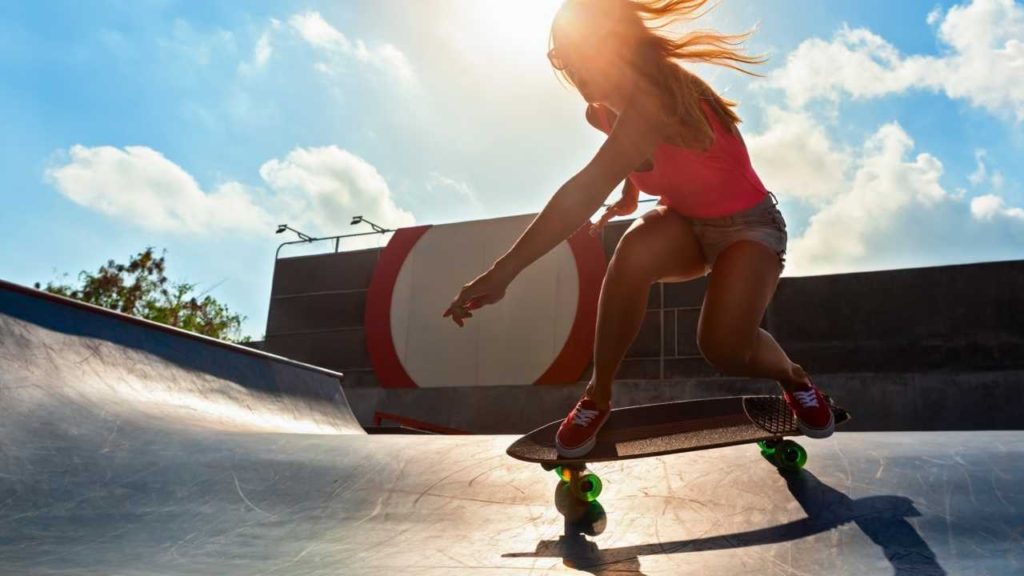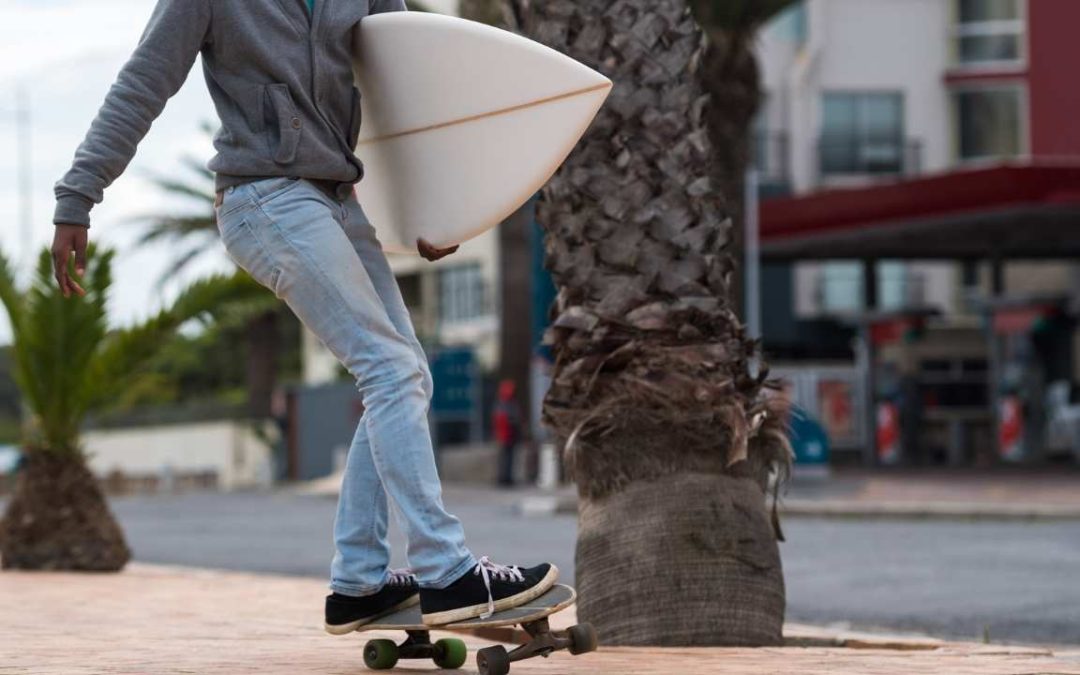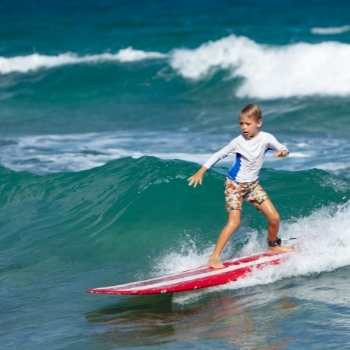Boardsports have definitely gained popularity in the last few decades and that popularity has absolutely soared since the Covid lockdowns of 2020. Seems like everyone is out there, getting into surfing or taking up skateboarding. Maybe youʻre interested in giving one of them a try?
Surfing is a harder sport to develop skills in than skateboarding, but itʻs a whole lot more forgiving on the body. Wave time on a surfboard is minuscule compared to the amount of time you can spend on a skateboard learning new tricks, making surfing much harder to learn.
That doesnʻt mean I would try. Why not do both? Surf when you can and skate when you canʻt surf. Best of both worlds, right?
The Five Differences Between Surfing And Skating?
The Playing Field:
Surfing involves riding a liquid and unstable surface. The only factor that is keeping you and your board afloat is momentum. However, the skateboarding surface is stable and predictable.
With surfing the waves are always changing and can crash or close off at any moment. The dynamic nature of a wave is what makes surfing more challenging than riding on solid ground.
Physical aspects:
Balance is required for both sports and therefore practicing this balance will improve your physicality for both sports.
However, 90% of surfing is paddling. Actually riding waves is only a small part of what surfers do. Catching the wave and the unique skills that are required to be in the right place at the right time is the most challenging part of the sport.
When compared to skateboarding the physical aspects are heavily reliant on leg strength, bodyweight shifts and hip rotations. If youʻre curious to learn more if a surf skate could help improve your surfing, be sure to read this post.
The environment:
Understanding the ocean is a key factor that makes surfing more difficult than skateboarding. Not only must a surfer be a strong swimmer but also be able to understand rips, tides, current and the weather.
Depending on where you choose to skateboard it can be in a less challenging environment. Commonly the environment is not constantly changing and is more in your control.
The learning curve:
Surfing has been commonly called the hardest board sport to learn. Surfers will admit that it takes months of hard work to begin to master the sport.
The main reason why this is a fact is that no two waves are the same. As there are no repetitive waves this means that every wave you catch will be slightly different. This uniqueness is challenging specifically for a beginner.
On a skateboard, you are able to practice the same move or trick over and over again in the exact same environment. However, in surfing, you have to wait to catch a similar wave to attempt that move again.
Anyone who has had a break from surfing will know that even a few weeks can cause you to lose some of the unique conditioning that is required to catch waves.
Skateboarding however can take just a few movements to be able to recondition yourself back to where you left off.
The injuries:
Falling from a skateboard is much more serious on a skateboard. Falling onto the hard surface will cause both small and large injuries. These consist of strains, road rash, cuts and bruises. More serious injuries include broken bones or even brain injuries (remember to always wear a helmet)
Falling off your surfboard does have risks, but unlike skateboarding, the ocean is a much softer landing zone. Hazards include physical aspects such as rocks, reefs and sandbars as well as getting caught inside of a big set wave, strong rips and getting hit by a surfboard. These injuries are less common and can be avoided with good ocean awareness.
To learn more about how hard surfing actually can be, click on over to this post and check it out when youʻre through with this one.
Does Skateboarding Help You To Surf Better?

With so many similarities between the two sports and the fact that skateboarding was invented by surfers the answer is yes!
There are many techniques that are similar between the two and skateboarding does in fact help you to become a better surfer.
In fact, a few skateboard manufacturers have created specially designed skateboards that mimic the movements of surfing more than a traditional skateboard. The OG surfskate in a world of multiple surfskate brands is put out by Carver Skateboards which you can find pretty easily on Amazon. They can be great tools to help improve your surfing.
Balance:
If you cannot get out into the ocean, spending time on a skateboard will allow you to work on your balance without having to paddle out.
Skateboarding is the closest that you can get to mimicking surfing balance. Understanding where your tipping point is will help you with both your surfing and skateboarding.
Flow:
Flow is crucial for creating and maintaining speed for both surfing and skateboarding. Practicing the small subtle movements of your lower and upper body while skateboarding in a controlled environment will help you to learn how your body movement affects the board.
When in the water next time you will only have a short period of time to practice this and if it has been practiced regularly on land then the muscle memory will kick in and help you.
Repetition and consistency:
Skateboarding allows you to have consistency while practicing your skills. While surfing there is no consistency as many elements are out of your control.
Not only is each wave different but they break differently, have lower or higher peaks and carry different amounts of water. This means that on every wave your body will need to be positioned differently through the wave.
Is Surfing The Hardest Sport In The World?
The basics of surfing can be picked up in a lesson with a surf coach however becoming good at surfing is considered very difficult. Understanding the movement of the ocean and knowing where to position yourself to catch the wave is something that can only happen with experience and time spent in the ocean.
Mastering all of this while perfecting your pop-up is only half of the battle as the water will always be changing. This means that with every wave comes its own unique set of challenges. The unpredictability of the ocean is the largest learning curve and this is not a factor when one learns to skateboard.
Even professional snowboarder Shaun White says in an interview with Stab Magazine “Yeah, I would rank it as the hardest one for me to do.” Even Shaun White admits that it is a difficult sport. This is due to the amount of effort, dedication and patience that it takes to become a surfer.
The mixture of skills that has to be combined in an ever-changing environment includes generating speed, positioning, wave knowledge, turns and riding the unbroken face of a wave.
Even though surfing is one of the hardest sports to learn it is worth the effort. There is something so unique and special about the experience that a surfer has while riding a great weave.
If you want to learn to surf don’t be discouraged by the amount of effort that is required to become a good surfer. Consistency and persistence are the key factors that will improve your surfing.
But you know the best thing that will help improve your surfing? Click over to this article in which I go over everything you need to know to Teach Yourself To Surf.



